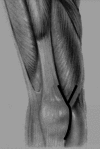The trivector approach for minimally invasive total knee arthroplasty: a technical note
- PMID: 22527151
- PMCID: PMC3427701
- DOI: 10.1007/s10195-012-0197-8
The trivector approach for minimally invasive total knee arthroplasty: a technical note
Abstract
One of the main criticisms of minimally invasive approaches in total knee arthroplasty has been their poor adaptability in cases of major deformity or stiffness of the knee joint. When they are used in such cases, excessive soft-tissue tension is needed to provide appropriate joint exposure. Here, we describe the "mini trivector approach," which has become our standard approach for total knee replacement because it permits us to enlarge the indication for minimally or less invasive total knee replacement to many knees where quad sparing, a subvastus approach, or a mini quad or mini midvastus snip may not be sufficient to achieve correct exposure. It consists of a limited double snip of the VMO and the quadriceps tendon that reduces tension on the extensor mechanism and allows easier verticalization of the patella as well as good joint exposure.
Figures




References
-
- Haas SB, Cook S, Beksac B. Minimally invasive total knee replacement through a mini midvastus approach. Clin Orthop. 2004;428:68–73. doi: 10.1097/01.blo.0000147649.82883.ca. - DOI - PubMed
MeSH terms
LinkOut - more resources
Full Text Sources
Medical

